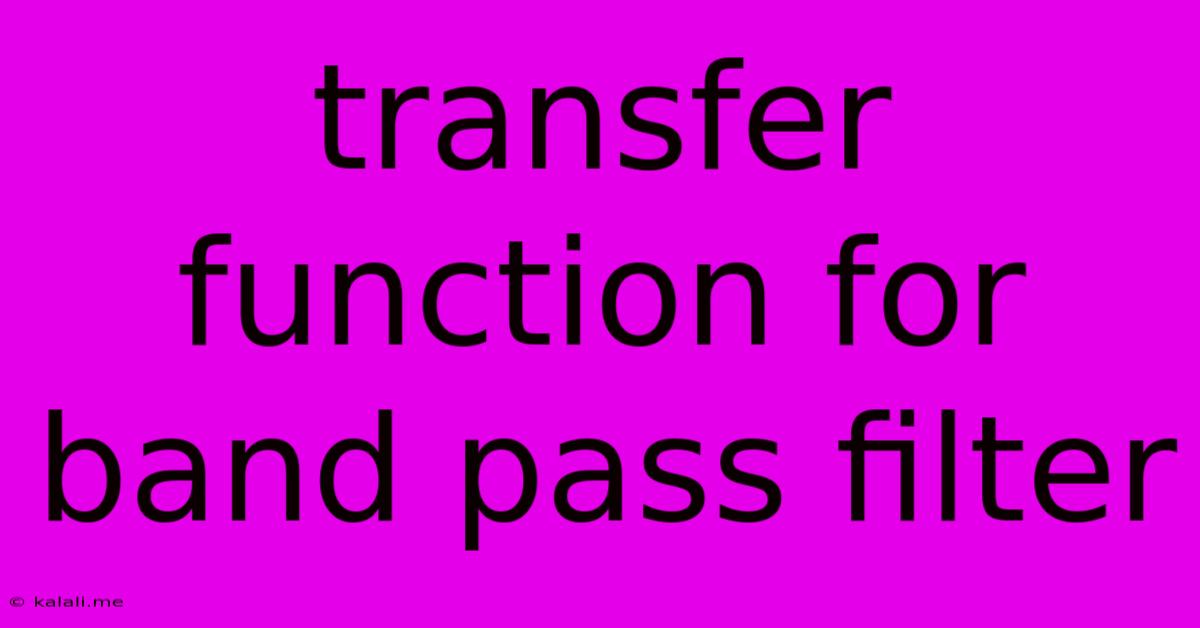Transfer Function For Band Pass Filter
Kalali
Jun 08, 2025 · 4 min read

Table of Contents
Understanding the Transfer Function for a Band-Pass Filter
The band-pass filter, a crucial component in signal processing, allows signals within a specific frequency range to pass through while attenuating frequencies outside this band. Understanding its transfer function is key to designing and analyzing these filters. This article will delve into the intricacies of the band-pass filter transfer function, exploring its derivation, characteristics, and practical applications.
What is a Transfer Function?
Before diving into the specifics of band-pass filters, let's briefly define a transfer function. In the context of linear time-invariant (LTI) systems, the transfer function, often denoted as H(s) or H(jω), describes the system's response to a complex sinusoidal input. It's essentially the ratio of the output signal to the input signal in the frequency domain (s-domain or jω-domain, where s = σ + jω). Analyzing the transfer function allows us to predict the system's behavior for various input frequencies.
Deriving the Transfer Function for a Band-Pass Filter
Band-pass filters can be implemented using various circuit topologies, including combinations of resistors, capacitors, and inductors (RLC circuits), operational amplifiers (op-amps), and active filter designs. The specific transfer function will depend on the chosen circuit configuration. However, we can examine a general approach.
A common approach involves cascading a high-pass filter and a low-pass filter. The high-pass filter allows frequencies above a certain cutoff frequency (f<sub>H</sub>) to pass, while the low-pass filter allows frequencies below another cutoff frequency (f<sub>L</sub>) to pass. The combined effect creates a band-pass response, passing frequencies between f<sub>H</sub> and f<sub>L</sub>.
The transfer function of a generic band-pass filter can be represented as:
H(s) = K * (s/ω<sub>0</sub>) / [(s/ω<sub>0</sub>)² + (s/Qω<sub>0</sub>) + 1]
Where:
- K: Gain constant representing the amplification within the passband.
- ω<sub>0</sub>: Center frequency (radians per second) – this is the geometric mean of the lower and upper cutoff frequencies.
- Q: Quality factor – a dimensionless parameter representing the filter's selectivity (sharpness of the passband). A higher Q results in a narrower passband.
This is a second-order transfer function, meaning it involves a quadratic polynomial in the denominator. Higher-order band-pass filters can be designed by cascading multiple second-order stages or utilizing more complex circuit topologies, leading to more intricate transfer functions.
Characteristics of the Band-Pass Transfer Function
Several key characteristics define the band-pass filter's transfer function:
- Passband: The frequency range where the filter provides significant gain. Ideally, the gain is constant across the passband.
- Center Frequency (ω<sub>0</sub>): The frequency at the center of the passband.
- Bandwidth (BW): The difference between the upper and lower cutoff frequencies (-3dB points). It's inversely proportional to the Q factor.
- Cutoff Frequencies (f<sub>L</sub>, f<sub>H</sub>): Frequencies at which the gain drops to -3dB (approximately 70.7% of the maximum gain).
- Roll-off: The rate at which the gain decreases outside the passband. This is often expressed in decibels per octave or decade.
- Phase Response: The phase shift introduced by the filter as a function of frequency.
Practical Applications
Band-pass filters have widespread applications in various fields, including:
- Audio Processing: Isolating specific frequencies in music or speech signals, such as separating vocals from instruments or enhancing certain frequencies for better sound quality.
- Communications Systems: Selecting specific channels in radio or television receivers, eliminating noise and interference.
- Medical Imaging: Filtering out unwanted frequencies in MRI or ultrasound signals to improve image quality.
- Control Systems: Filtering out noise and unwanted signals in feedback loops.
- Instrumentation: Selecting specific frequencies for measurement and analysis.
Conclusion
The transfer function provides a powerful mathematical tool for understanding and designing band-pass filters. By analyzing its characteristics, such as the center frequency, bandwidth, and quality factor, engineers can precisely tailor filter responses to meet specific application requirements. Understanding the relationship between the transfer function and circuit parameters is fundamental to filter design and optimization across various disciplines. Further exploration into specific filter topologies and their corresponding transfer functions will offer a deeper understanding of their unique properties and applications.
Latest Posts
Latest Posts
-
Alternative To Parchment Paper For Baking
Jun 08, 2025
-
Propane Heater Wont Stay Lit After Releasing Button
Jun 08, 2025
-
How Often To Change Spark Plug
Jun 08, 2025
-
Matrix Object How To Display Spheres
Jun 08, 2025
-
How To Clean Rusty Gas Grill Grates
Jun 08, 2025
Related Post
Thank you for visiting our website which covers about Transfer Function For Band Pass Filter . We hope the information provided has been useful to you. Feel free to contact us if you have any questions or need further assistance. See you next time and don't miss to bookmark.